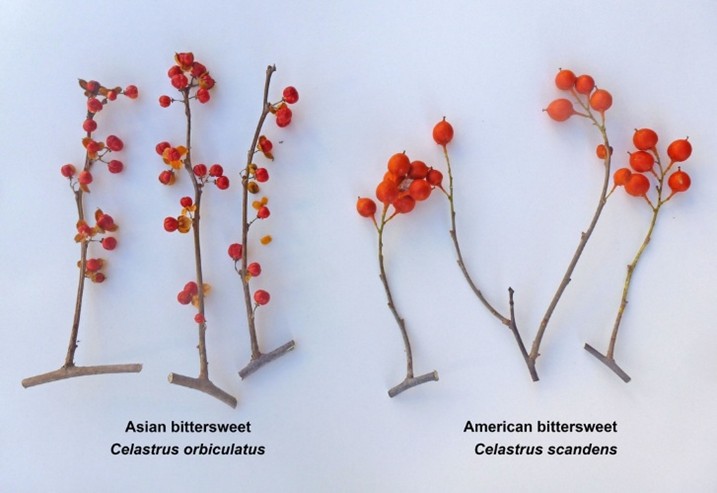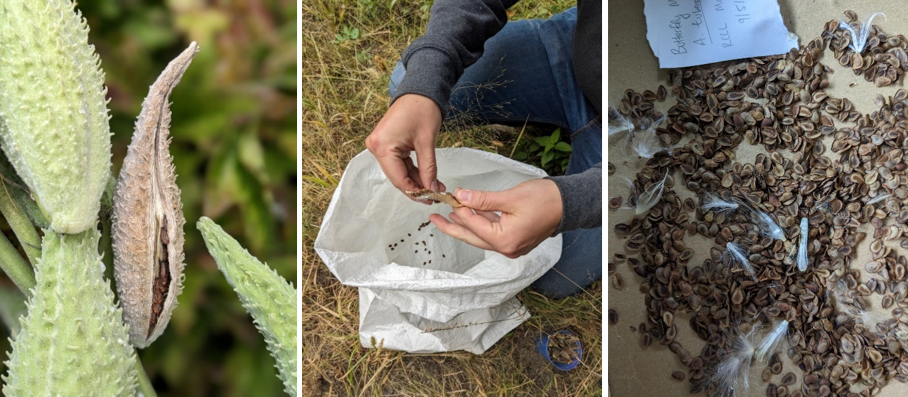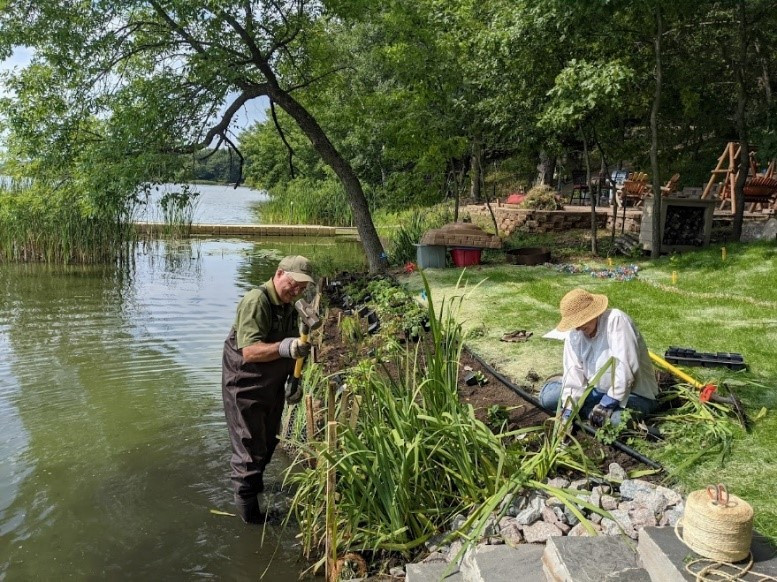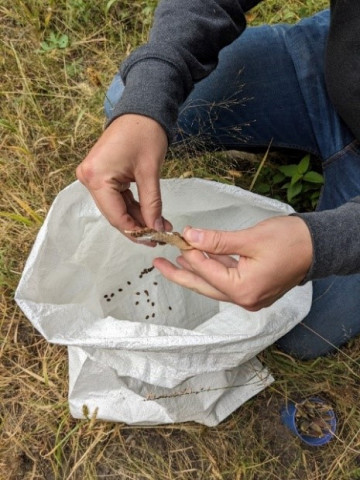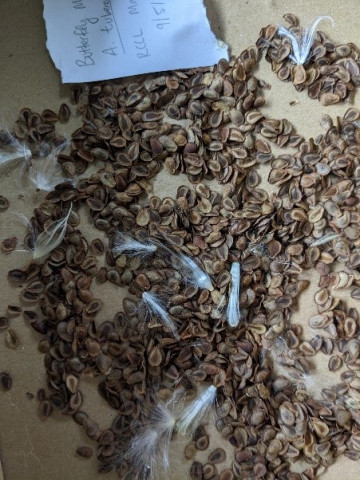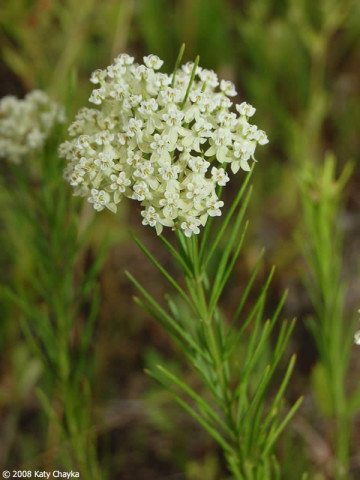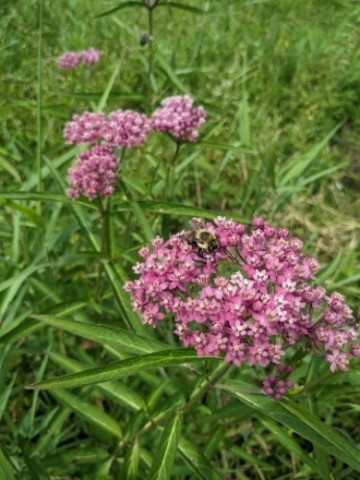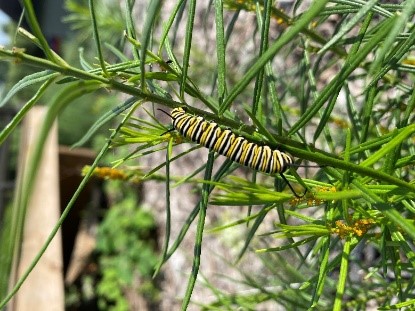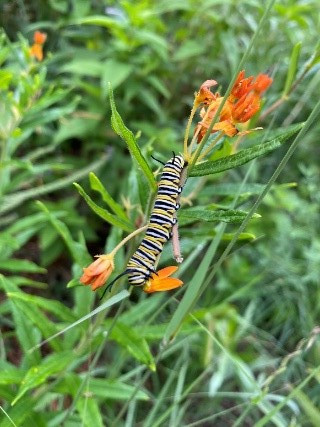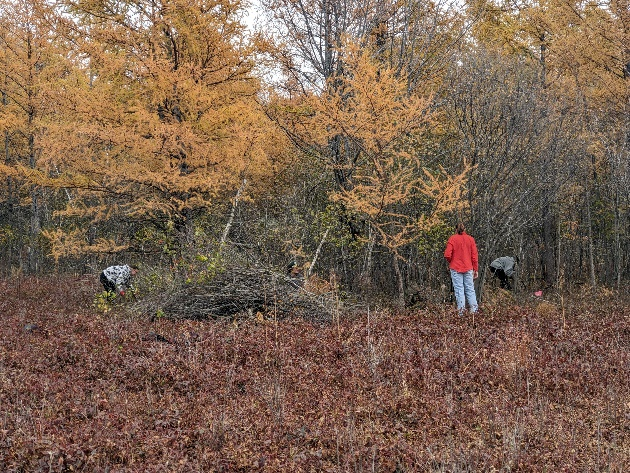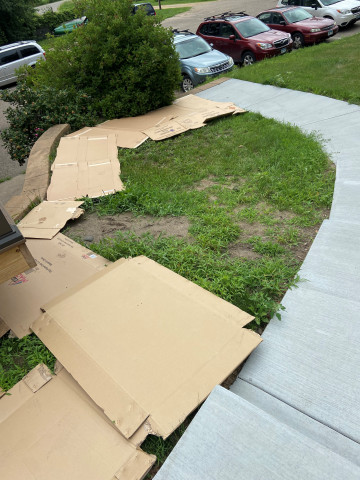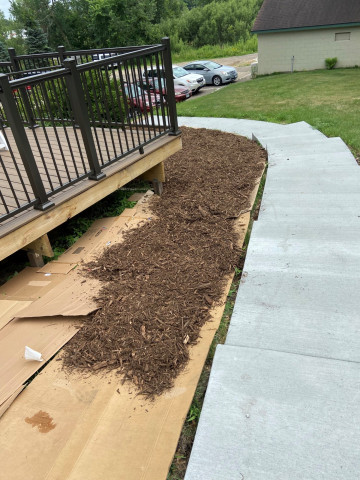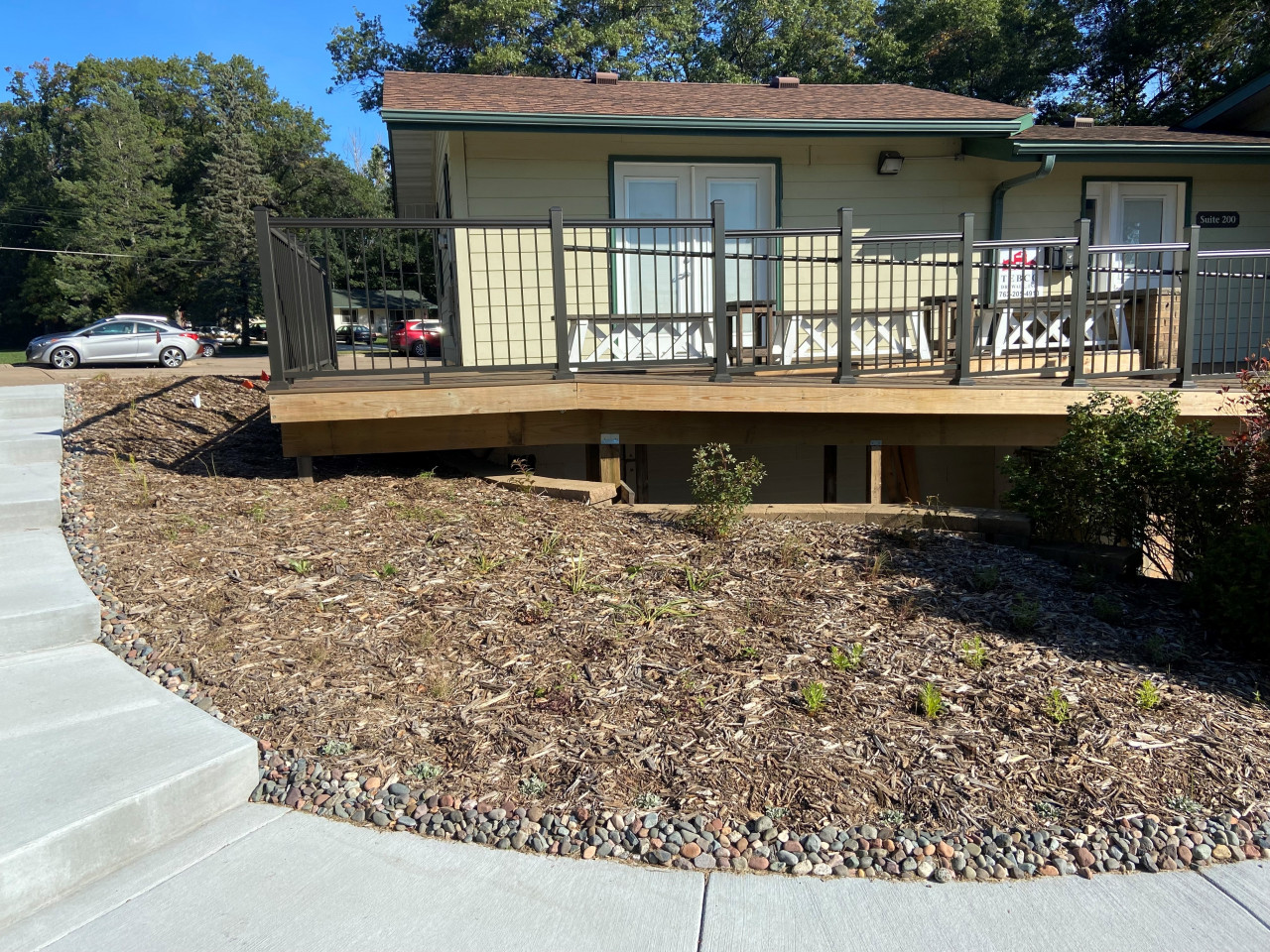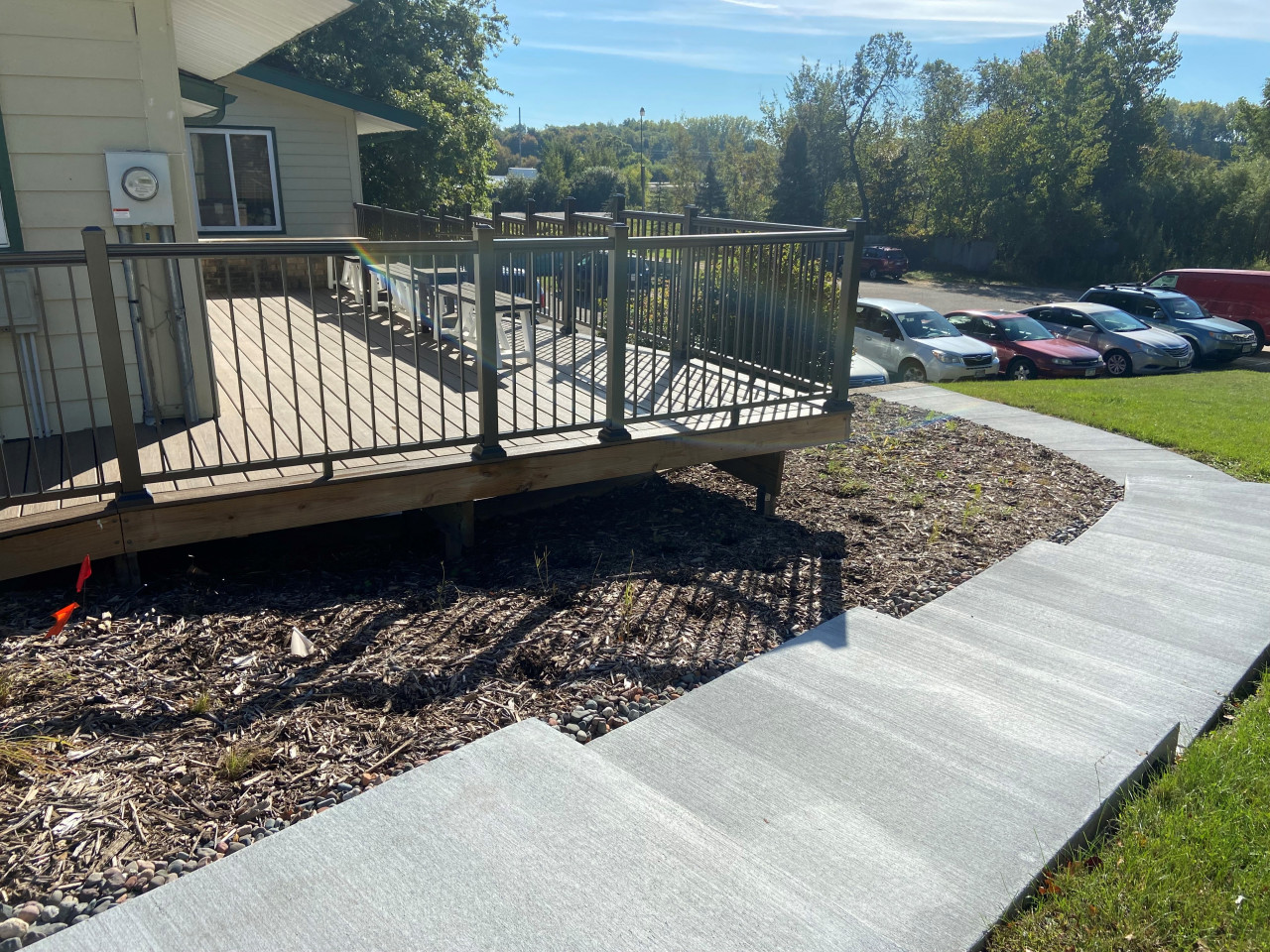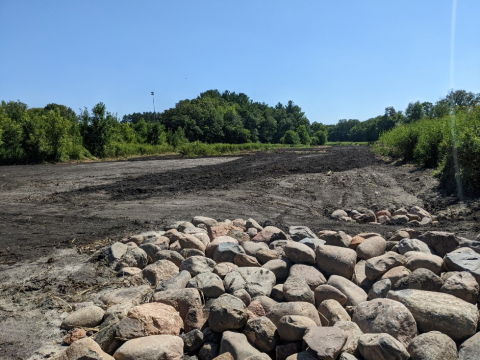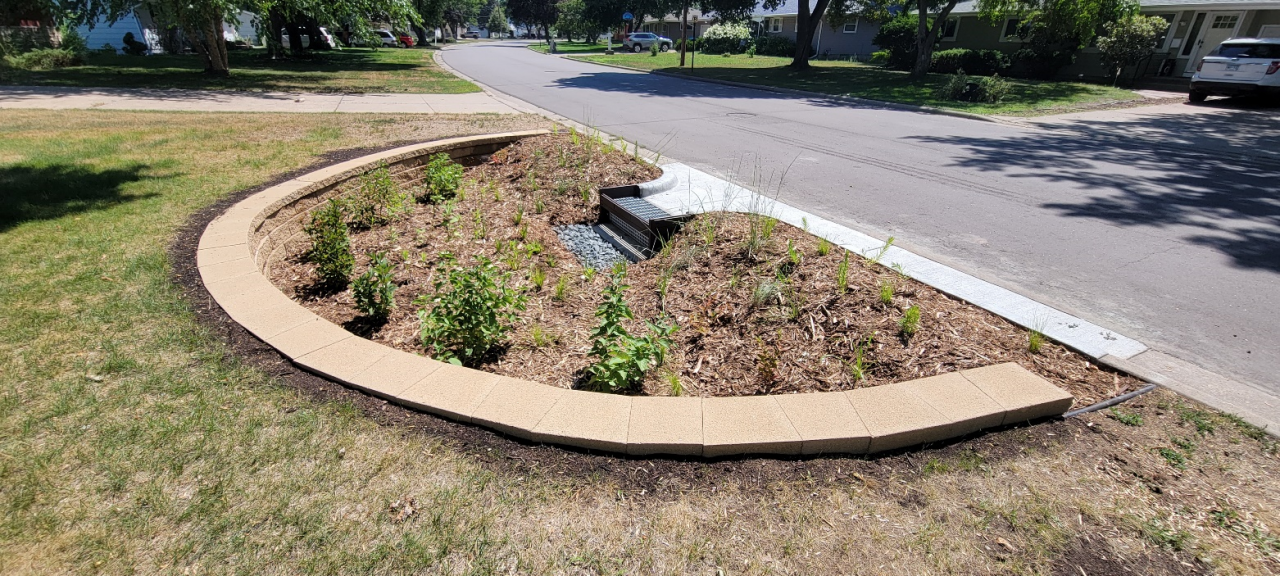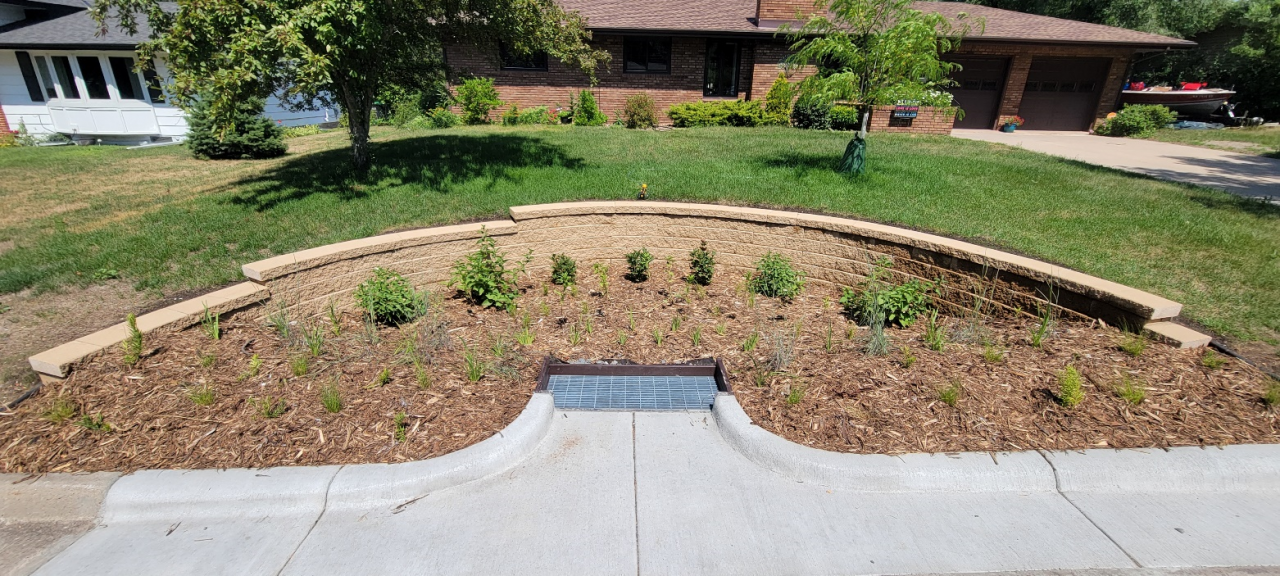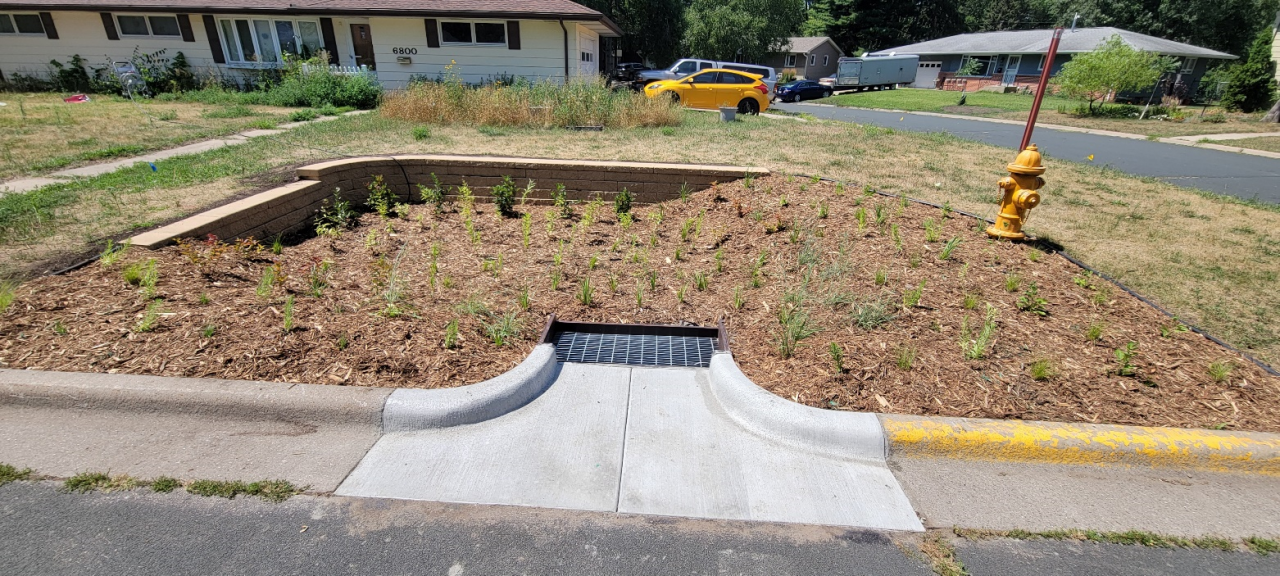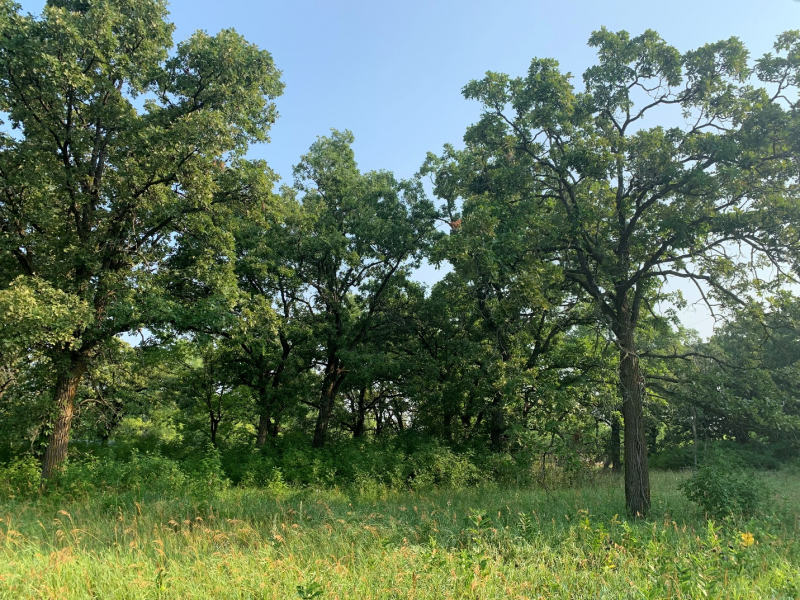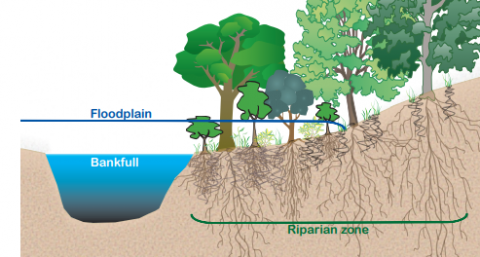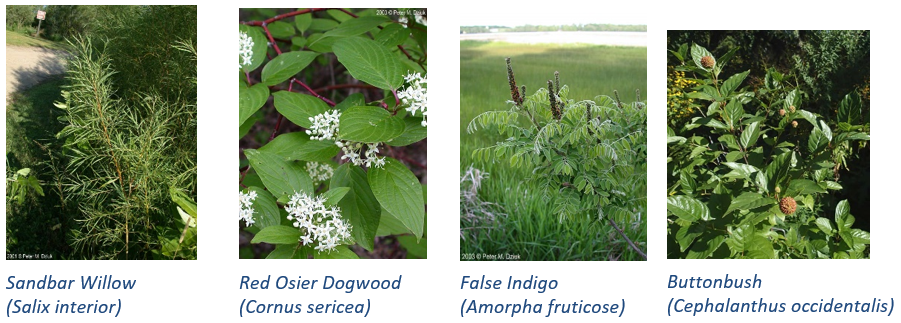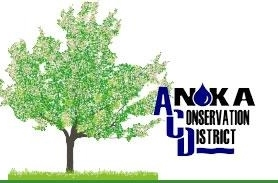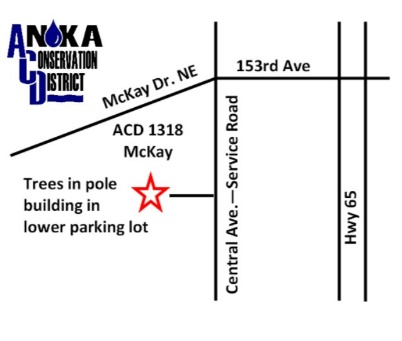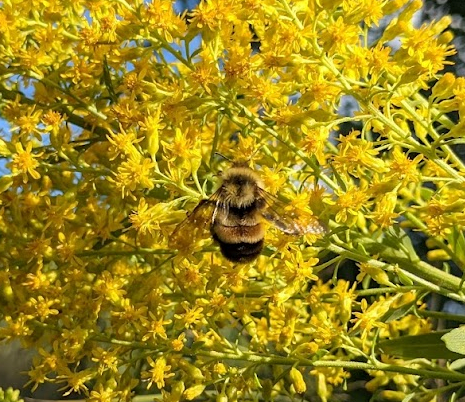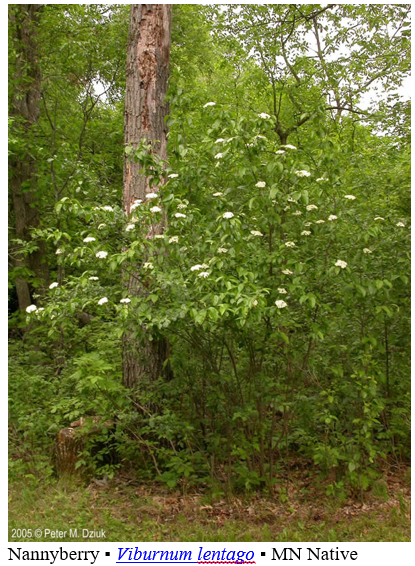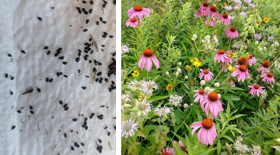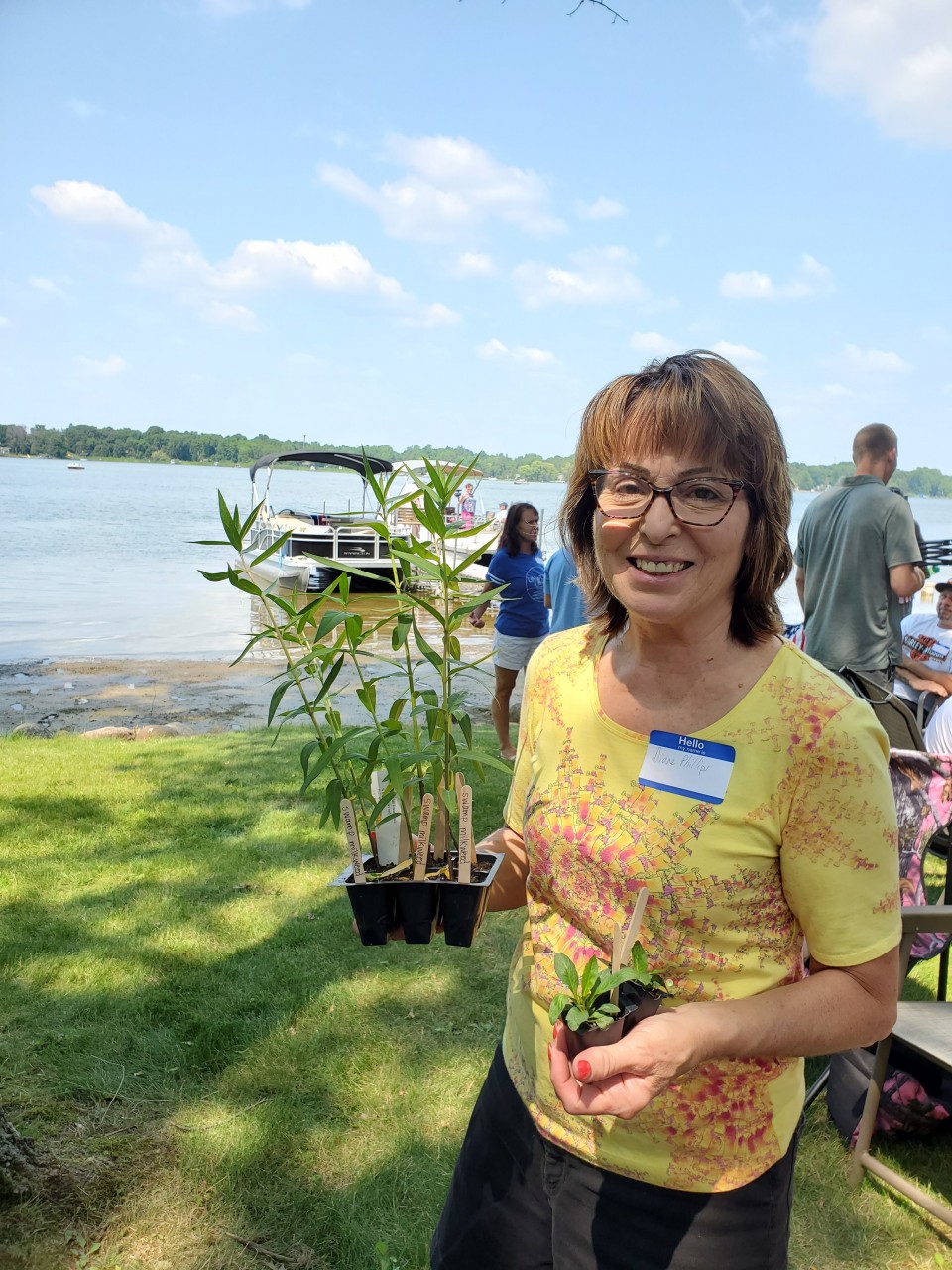ACD staff and volunteers planted 120 new trees on Kings Island in Anoka, Minnesota. After more than 420 ash trees were removed due to Emerald Ash Borer infestation, this reforestation effort aims to restore a diverse, resilient forest. Species planted include hackberry, basswood, river birch, tulip poplar, sycamore, northern pecan, and more.
Roundleaf bittersweet (Celastrus orbiculatus) is a large woody vine that was introduced in the 1860s. If left unchecked, infestations can overtake and choke out whole forests, with the vines sometimes growing as large as the trees that they grow on!
The best way to tell the difference between the invasive and native American bittersweet is by looking at the fruits (see image above). Additionally, the native bittersweet rarely forms dense thickets like the non native species does. A good way to control large plants of roundleaf bittersweet is to cut the vine near the ground and apply an herbicide solution to the cut stump. Smaller vines can be brush cut or mowed (be sure to collect and dispose of the fruits!) in the winter, and the new leaves can be sprayed with herbicide in the spring.
Do you have native milkweed plants on your property? If so, early fall is a perfect time to collect seeds. Seeds are mature and ready for collection once they have turned a darker brown. Milkweed pods will turn from green to brown, start to open up and reveal the brown seeds inside. Pods will continue to open and the seed will fly out and disperse. However, it's ideal to collect seeds before the pods fully open and the seed fluff/silk has developed. It is best to remove the fluff from the seed for storage. To separate the seed from the fluff, remove the entire stalk of seeds and fluff/silk from the seed pod, hold the end of the fluff/silk and gently push and pull the seeds off the fluff/silk. Watch this short video to see butterfly milkweed seed cleaning. Once the seed is "cleaned" (the fluff is removed), lay it out to dry completely, label the seed with the plant species name (common or butterfly milkweed), and write the date and location the seed was collected. Store dry seed in paper or mesh plastic bags.
ACD collaborates with Anoka County Parks and cities within Anoka County to enhance local native habitats. If you have native milkweed seed you would like to donate, ACD staff will be happy to take it and spread the seed at appropriate locations.
Contact Carrie Taylor, Restoration Ecologist, at
Here are ways you can help pollinators and birds in your yard:
- Plant Native Plants
- Don't Buy Plants Treated with Neonicotinoids
- Avoid Pesticides
- Provide Water or a Birdbath
- Leave Bare Soil and Old Stems for Bee Nests
Apply to ACD's Lawns to Legumes Pollinator Pathway Native Plant Grant:
Eligible project practices include:
- Native pocket plantings
- Beneficial flowering tree and shrub plantings
- Pollinator-friendly lawns
- Pollinator meadows
Applications can be submitted via Google Forms or paper applications are available upon request. Questions can be directed to Jordi Johnson:
ACD's pollinator conservation programs were made possible by grant funding from BWSR and the National Fish and Wildlife Foundation's Monarch Conservation program. For more information contact Logan Olson, Restoration Technician, at
Do you want to start a new garden or fill in some gaps? Fall is a great time to plant. The soil is still warm and promotes good root growth and the cooler weather and fall rainfall reduce heat stress on new plants. Select plants based on the area's soil moisture and light exposure. Blue Thumb's Plant Finder is a great tool for selecting native plants and has a list of MN native plant nurseries. Protect pollinators! - Be sure the plants you buy were not grown with systemic pesticides such as neonicotinoids, which are highly toxic to bees and other pollinators.
Choose plants to create habitat for birds and pollinators. Find bird-friendly native plants with Audubon's plant database. Select plants that flower from spring to fall to provide pollen and nectar for pollinators. Learn more about pollinator preferences and include host plants in your garden. Join ACD and help plant pollinator gardens throughout Anoka County. Learn more and sign up here. For more information contact Carrie Taylor, Restoration Ecologist, at
This June, ACD is planting 10 lakeshore buffers, part of a shoreline stabilization totaling nearly 800 feet of shoreline at three lakes. Native plants help hold in place the shoreline soils against erosion and provide near shore habitat. ACD and its project partners, such as the Sunrise River Watershed Management Organization, have goals of increasing native and stable shorelines.
"Disappearing" natural shorelines is affecting lake health at many waterbodies in the region. ACD staff regularly assists homeowners who wish to do native shoreline buffers. With a little guidance, these projects can be do-it-yourself installation, or professionally installed. Cost share grants are available. Big or small, each is a step toward healthier, cleaner lakes and rivers. For more information contact, Watershed Projects Manager, Jamie Schurbon at
Dreaming of warmer weather and gardening season? Applications are now open for Fall 2024 individual Lawns to Legumes grants! Minnesota residents are eligible to apply for $400 reimbursement grants for creating native pollinator habitat on their properties. Projects can take the form of small pocket plantings, larger pollinator meadows, or pollinator friendly lawns.
Grant recipients are selected by a lottery system. The application closes on May 15th. Check out the MN Lawns to Legumes page for a plethora of resources on pollinator garden design, selecting native plant species, and maintaining pollinator habitat.
Note: Individual Lawns to Legumes grants are distributed at the state level, not by ACD. You can find contact information for assistance with these programs at the links above.
Do you have native milkweed plants on your property? If so, early fall is a great time to collect seed. Seeds are mature and ready for collection once they are darker brown. Milkweed pods will turn from green to brown, start to open up and reveal the brown seeds inside. Pods will continue to open up and the seed will fly out and disperse. However, it's ideal to collect seed before the pods fully open up and the seed fluff/silk develops. It is best to remove the fluff from the seed for storage. To separate the seed from the fluff, remove the entire stalk of seeds and fluff/silk from the seed pod, hold the end of the fluff/silk and gently push and pull the seeds off the fluff/silk. Watch this short video to see butterfly milkweed seed cleaning. Once the seed is "cleaned" (the fluff is removed), lay it out to dry completely, label the seed with the plant species name (common or butterfly milkweed), and write the date and location the seed was collected. Store dry seed in paper or mesh plastic bags.
ACD collaborates with Anoka County Parks and cities within Anoka County to enhance local native habitats. If you have native milkweed seed you would like to donate, ACD staff will happily take it and spread seed at appropriate locations. Contact Carrie Taylor, Restoration Ecologist, at
Meet The Milkweeds
Monarch caterpillars feed exclusively on the leaves of milkweed. Let's help feed these hungry caterpillars!
Native wildflowers, grasses, sedges, and shrubs provide numerous benefits to wildlife habitat, soil health, and water quality. They are also generally more resilient to fluctuations in temperature, precipitation, and foraging by wildlife than non-native species. However, native plantings can still be impacted by disturbances such as weather or the growth of invasive and weedy species. For these reasons and especially if a specific landscaped look is desired, maintenance is still required to help native plantings thrive and look their best.
Plants are most susceptible to die-off within the first 3-5 years of being planted. During this initial period, it is essential to frequently weed, water, and re-plant in areas where losses occur. Once established, native vegetation requires less maintenance but should still be regularly inspected for weeds and pruned or thinned as needed to ensure there is adequate sunlight available for all species. Large-scale restorations such as the conversion of former agricultural fields to prairie may require regular management through prescribed burns, grazing, or mowing to mimic cycles of natural disturbance and new growth.
The most common barriers to achieving success in establishing native plants is failing to water and remove weeds. These two actions make a big difference in the appearance and function of native landscaping features, as shown in these two photos – one of which is regularly weeded and watered (above left) and the other which has received less maintenance (above right).
You can take several steps to make native landscape maintenance easier. First, make sure the species you plant are well-suited to the soil and sunlight conditions on your property. Plant into erosion control fabric or mulch to help reduce weed growth. Learn to identify the native species you choose and plant them in clusters to make it easier to spot weeds that pop up. Water native plantings, especially during times of drought. Weekly maintenance, especially during the critical establishment period, strongly increases the likelihood of success and prevents these tasks from becoming overwhelming. If weeds have taken over or you've noticed die-off in your native landscapes, it isn't too late! Use the following resources to help guide your native landscape rehabilitation endeavors.
- Common weed ID – quick guide
- Invasive plants and suggested replacements
- Comprehensive information: native plants for sustainable landscapes
ACD staff have been collaborating with Professor Kristen Genet to create hands-on learning opportunities for an Anoka-Ramsey Community College Ecology class. The class learned about rare plants, rare habitats and the invasive species that threaten them, and provided service through their learning. The class got out to plant native grasses and wildflowers to create a dry prairie pollinator garden in a Coon Rapids park. They also conducted rare plant surveys to help guide rare plant rescue planting densities and removed buckthorn that was starting to grow into areas with rare plants. Thanks to Kristen Genet and students for all their contributions!
Plant species that are "native" to a local area (i.e., grow there naturally) provide necessary food and habitat for pollinators and enhance soil and water quality. Outdoor spaces that are in covered in turf provide very few benefits to pollinators or the environment, so frequent pockets of natural spaces are critical in developed areas. We recently converted part of our office property from an area that was annoying to mow into beneficial pollinator habitat! Here's how we did it:
In early summer, we used "sheet mulching" to kill off the grass and weeds. If you can plan to have a couple of months before planting, this is an easy method to prepare a site without using herbicides. The future garden space was fully covered in cardboard sourced from our local recycling facility and then covered with a couple inches of mulch. This effectively smothered existing weeds.
We selected 11 native wildflower species, 2 native shrub species, and 2 native grass species for the garden that will thrive with the amount of natural sun and water that the spot gets. Adding wildflowers is a no-brainer to provide nectar for pollinators, but adding grasses sometimes gets overlooked in pollinator gardens. Native grasses provide homes for insects to overwinter in and add beautiful texture to a space! There are many great places to order native plants from in Minnesota; we used Minnesota Native Landscapes and Glacial Ridge Growers.
Since our garden is next to a sidewalk, it was lined with river rock to create a cleaner look and contain the mulch.
In early fall, the plants arrived and were planted. By this time, the cardboard underneath had broken down enough that it was easy to rip gaps in it to dig holes for the plants. Autumn planting gives plants an edge for developing strong roots in their new home and is a great option if you miss the spring planting window. The plants were spaced about 1.5 feet apart to leave them with room to grow into their full-sized forms. The already-present mulch will help hold in water and continue to suppress weeds.
It will be exciting to watch these new plants grow over the coming year to create a beautiful spot that will support some of our essential pollinator species in Anoka County.
You can also follow these steps to convert areas of your property that may not get much traffic or are hard to mow into a space that will benefit everyone!
Anoka Conservation District, the U.S. Fish & Wildlife Service, The Nature Conservancy, and the City of Andover are working together to restore natural hydrology and establish native vegetation at Pine Hills North Park in Andover.
A private ditch was plugged and weeds in the basin were scraped and used to fill in the ditch, preventing drainage of water and recreating the conditions of a wetland. The scraped area will be seeded with a mesic prairie seed mix in the fall.
"Try it, and you'll like it. The first one's free." A free trial can be just what's needed to break through to new customers. At the 2021 & 2022 Linwood Lake Improvement Association annual picnics, the Anoka Conservation District distributed nearly 200 native shoreline plants to be planted all around the lake at 25+ different properties.
Native plants can mean "weeds" to some folks. Or just out of the comfort zone. But the right plant in the right place is beautiful and effective. On shorelines there are a variety of native plants that are the perfect choice– beautiful, strong, and well-adapted to the wet. Good habitat too. They're key to a stable shore and healthy lake.
Thanks to Minnesota Native Landscapes, Inc. who provided the giveaway plants this year. ACD offers technical help and grants for those wanting to do a larger shore stabilization or buffer project.
Construction is complete for six rain gardens at residential lots in the Rice Creek Terrace neighborhood in the City of Fridley. These rain gardens were placed at high priority locations to intercept and treat stormwater before it enters Rice Creek. The locations were identified during a Lower Rice Creek Stormwater Retrofit Analysis conducted by ACD in partnership with the City and the Rice Creek Watershed District. The rain gardens were funded by the RCWD's water quality cost share program and the City of Fridley. Landowners have all agreed to long-term maintenance of the gardens to ensure optimal and continuing stormwater treatment.
Cumulatively, the six rain gardens are estimated to infiltrate 455,000 gallons of water, as well as remove 605 pounds of sediment and two pounds of phosphorus loading to Rice Creek annually. All six rain gardens are vegetated with native plants to maximize infiltration and provide the co-benefit of pollinator habitat. Additionally, one rain garden is located immediately adjacent to a trail entrance into Locke County Park, providing an excellent public education opportunity.
Over the next two to three years, the native plant plugs will get much bigger, filling the gardens with color and life. To see other rain gardens already installed throughout Anoka County, please see the virtual project tour on ACD's website. See photos of all six new rain gardens above.
Anoka Conservation District recently submitted two proposals, HRE07 Rum River Corridor Fish and Wildlife Habitat Enhancement – Phase 2 and HA02 Anoka Sand Plain Habitat Conservation – Phase 8 to the Lessard-Sams Outdoor Heritage Council ML 2023 Request for Funding. The proposed activities will enhance aquatic and terrestrial habitat in Anoka County and collaborate with Partners in the Rum River Corridor and the Anoka Sand Plain Ecoregion.
HRE07 Rum River Corridor Fish and Wildlife Habitat Enhancement – Phase 2
$3.5M request ($3M for Anoka County) includes:
- Streambank and in-channel stabilization (2,200 linear feet);
- In-stream fish habitat with a focus on game fish (1,200 linear feet); and
- Riparian forest, wetland, and prairie enhancement in the Shoreland Zone (118 acres) including wild rice habitat on tribal lands.
Partners:
- Anoka, Isanti and Mille Lacs SWCDs
- Anoka and Isanti Counties
- Upper and Lower Rum River WMOs
- The Nature Conservancy
- Mille Lacs Band of Ojibwe
HA02 Anoka Sand Plain Habitat Conservation – Phase 8
$8.9M request ($2.15M for ACD) includes:
- Conservation easements (540 acres)
- Habitat restoration and enhancement (1,736 acres and 2,200 linear feet of shoreline)
- Rare plant rescue program
Six rain gardens are being installed at residential lots in the Rice Creek Terrace neighborhood in the City of Fridley. These rain gardens are being placed at high priority locations to intercept and treat stormwater before it enters Rice Creek. The locations were identified during a Lower Rice Creek Stormwater Retrofit Analysis conducted by ACD in partnership with the City and the Rice Creek Watershed District. The rain gardens are being funded by the RCWD's water quality cost share program and the City of Fridley. Landowners have all agreed to long-term maintenance of the gardens to ensure optimal and continuing stormwater treatment.
Cumulatively, the six rain gardens are estimated to infiltrate 455,000 gallons of water, as well as remove 605 pounds of sediment and two pounds of phosphorus loading to Rice Creek annually. All six rain gardens will be vegetated with native plants to maximize infiltration and provide the co-benefit of pollinator habitat. Additionally, one rain garden will be located immediately adjacent to a trail entrance into Locke County Park, providing an excellent public education opportunity.
Watch for additional updates as construction is finalized. To see other rain gardens already installed throughout Anoka County, please see the virtual project tour on ACD's website.
BWSR awarded ACD $40,000 for the Habitat Enhancement Landscape Pilot Program. ACD, Anoka County Parks, City of Blaine and City of Fridley identified project sites to create species rich, diverse prairies. There are 12 prairies identified in Anoka County Parks land with low forb diversity within the Rusty Patched Bumble Bee priority area that will be enhanced. Turf to prairie conversion will occur on a total of 4.75 acres at Fridley Commons Park, Blaine Laddie Lake, Coon Rapids Dam, Rice Creek West Regional Trail and Bunker Regional Park. These projects range from 0.25 to 1.5 acres and will be forb-rich.
Last year, over 3,000 linear feet of cedar tree revetments were installed on the banks of the Rum River in Anoka County. While the cedar trees themselves will help capture sediment and prevent further erosion throughout the coming years, the re-establishment of native riparian vegetation is essential for promoting long-term bank resiliency. In May, ACD staff, with assistance from Anoka County Parks staff, planted a total of over 1,000 plants across six cedar revetment sites; species planted included sandbar willow, red osier dogwood, false indigo, and buttonbush (pictured below).
When present, the deep roots of native trees, shrubs, grasses, and other vegetation act like a net, securing the bank's soils and preventing them from washing away. Streambank vegetation also provides essential habitat for many aquatic and terrestrial species. For these reasons, ACD incorporates native plantings into all streambank stabilization projects.
Pre-ordered trees & shrubs will be ready for pick up on April 30th, staggered by last name.
DATE AND TIME: Saturday, April 30. Staggered pick up by first letter of Last Name:
A-D: 9-9:30am P-S: 11:15-11:45am
E-J: 9:45-10:15am T-Z: 12-12:30pm
K-O: 10:30-11am
PICK UP LOCATION: ACD Office- 1318 McKay Drive NE Ham Lake LOWER LOT
- We strongly encourage you to come during your timeslot
- Drive-thru pick up to comply with social distancing
- Make space ahead of time so ACD staff can put your order in your vehicle
- Refer to www.AnokaSWCD.org for up-to-date information
- Ask a neighbor or friend to pick up if you can't make it
- Parking lot is too small, so no large trailers!!
Storing your seedlings until they can be planted:
- Store trees and shrubs in a cool, dark location (garage or shed)
- Your trees and shrubs should be fine stored for up to 3 weeks
- Keep roots moist but don't fill bag with water or put roots in a bucket of water
- Roots have been dipped in root gel and bagged to keep them moist
Questions?
1st, try: www.AnokaSWCD.org
2nd, email:
Anoka CD, in partnership with Rice Creek Watershed District, Coon Creek Watershed District, City of Fridley, Coon Rapids, Blaine and Lino Lakes, received BWSR grant funds to create a pollinator corridor in the North Metro. These cost share funds are available to local residents and public spaces (e.g. places of worship and libraries) who are interested in creating pollinator habitat. Eligible projects include native pocket plantings, pollinator beneficial trees and shrubs, pollinator lawns and pollinator meadows to benefit the rusty patched bumblebee and other at-risk species.
Contact Carrie at
Spring is around the corner and that means it is time to think about what to plant. Ornamental plants are not native to MN and therefor do not provide as quality of a food source to pollinators or wildlife. Some ornamentals have started to spread to natural areas where they can cause ecological harm. Amur maple, Norway maple and Winged burning bush have been common landscaping plants but their spread into natural areas has been detected. That invasive behavior landed them on the MN Noxious Weed List as Specially Regulated Plants. There are many native plants to choose from that are suitable for landscaping. See the Woody Invasives of the Great Lakes Collaborative website's Landscape Alternatives for native plant ideas. Blue Thumbs Plant Finder is a great tool to determine the best native plants for your site conditions. Many MN natives are available at local plant nurseries.
| Avoid | Choose Instead |
| Amur Maple | Mountain maple, pagoda dogwood, high bush cranberry, fireberry hawthorn |
| Norway Maple | Red maple, sugar maple, hackberry, basswood |
| Winged Burning Bush | Leatherwood, pagoda dogwood, nannyberry, wolfberry |
There is so much magic and joy in starting wildflowers from seeds. This is a good time to start that process for many native plants so that they are ready in the spring. Many native plants' seed stays dormant until there are good conditions in the wild. As a gardener, you can create these conditions to break dormancy for seed germination. Many native seeds need cold moist stratification to germinate. This can be done outdoors if seed is planted in the fall and overwintered. If you want to start them indoors in containers then pre-treatment stratification is needed. Stratify by placing seeds in a damp paper towel, coffee filter, or sand and into a sealed plastic bag in the refrigerator (33-40 °F). Native plant's seeds range from needing 10 to 120 days of cold stratification. Once seeds have been stratified for the number of recommended days, plant seeds in a soil medium. Keep soil moist until seeds sprout and send up their first leaves. Water as needed and allow the soil to begin to dry out between watering. The magic continues as plants continue to grow!
Learn more about individual native plant seed pre-treatment and germination strategies in the Prairie Moon Nursery 2022 Cultural Guide and Germination Guide and the Tallgrass Prairie Center's Native Seed Production Manual.
If you aren't ready to start a new seed starting hobby, this is also a good time to start designing and planning a pollinator garden. Many local plant vendors have their plant catalogues ready for you to view. Be sure that plants you purchase are free of neonicotinoids, which are very toxic to pollinators.
See BWSR's Lawns to Legumes page for garden design templates and list of local native plant vendors.
"Try it, and you'll like it. The first one's free." A free trial can be just what's needed to break through to new customers. At this year's Linwood Lake Improvement Association annual picnic, the Anoka Conservation District distributed nearly 100 native shoreline plants to be planted all around the lake at around 20 different properties.
Native plants can mean "weeds" to some folks. Or just out of the comfort zone. But the right plant in the right place is beautiful and effective. On shorelines there are a variety of native plants that are the perfect choice –beautiful, strong, and well-adapted to the wet. Good habitat too. They're key to a stable shore and healthy lake.
Thanks to Prairie Restorations, Inc who provided the giveaway plants. ACD offers technical help and grants for those wanting to do a larger shore stabilization or buffer project.
I noticed my neighbors doing this in their backyard. At first, I thought it was odd and might attract unsavory characters to the neighborhood and bring down property values. Now, I'm a card carrying member of the Rewild Club. It's best to explain.
I took a hard look at my yard and ask myself…What do I want from this space?
- A peaceful shady retreat?
- Home grown food?
- Entertainment central?
- Ruckus area for kids and pets?
What do I need to make that happen? A patio, a water feature, play area, shade trees, garden plot, privacy screening, a lawn area for recreation, disco ball and dance floor, an amphitheater for Shakespeare in the Park night?
I realized that my yard was mostly seldom-used lawn and none of the other fun stuff.
Amphitheater and disco balls aside, I started to pull together a plan. The biggest surprise was how much better my yard would be if I did less work. I opted to rewild unused space. Along the perimeter of my yard I stopped mowing, I stopped raking, I stopped fertilizing, I stopped weeding, and I stopped watering. In other words, I released by inner teenager. I let trees and shrubs that popped up keep growing, and planted a few for fall color, nesting, fruit and flowers. In a few years, instead of staring at a fence that needed maintenance, I had a living screen of trees and shrubs. Birds and butterflies came back to enjoy the flowers and fruits of my lack of labor, and they turned out not to be the unsavory characters I had imagined. The shade makes hot summer days in the yard enjoyable and cuts my lawn watering in half. There still plenty of lawn for kids and pets, but now the space is a haven for the family and a little wildlife.
Tips for the would-be rewilder.
- Just mow less.
- Baby steps. Pick a small area to try first. Consider it a journey of many years, not a mountain to climb on a single trek.
- Forget tidy. Wild areas can be messy. You can keep the edges formal if you want.
- Pick up ID books for birds, flowers, and trees so you can get to know your new neighbors. Books? Did he say books? I think he meant App.
- Avoid using chemicals where the wild things are.
- Think vertically if you have a small space. Tall trees, medium sized trees, shrubs, wildflowers and grasses can call have a place in a very small area.
- Add a water feature to ramp up the wildlife appeal.
- Plant diversity is good. Variety will make the space more interesting and resistant to stressors like disease and drought.
- Speed up the process with affordable bare root trees and shrubs from your local conservation district annual tree sale.
- Avoid invaders. Learn a few of the invasive plants in your area and try to keep them out of your wild space.
- Let your neighbors know why you would do such zaniness.
If you are looking for a low maintenance option to benefit native pollinators, consider planting native trees and shrubs. They provide overwintering habitat and food sources for our native bees, butterflies, moths, flies, wasps, and beetles. Many trees and shrubs bloom in the spring and provide an early nectar and pollen source. Fun fact from Heather Holm: One, 70 foot tall, mature black cherry tree (photos below) has the equivalent number of flowers as a 3,500 square foot perennial garden.
ACD's Annual Tree sale has a wide variety of trees and shrubs to choose from! See the full catalog here: https://www.anokaswcd.org/tree-sale-order-forms/2012-10-26-17-32-43.html
See Heather Holm's Native Tree and Shrubs for Pollinators guide for more information: https://www.pollinatorsnativeplants.com/uploads/1/3/9/1/13913231/treesshrubsposter.pdf
